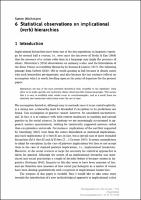Chapter 6 Statistical observations on implicational (verb) hierarchies
| dc.contributor.author | Wichmann, Søren | |
| dc.contributor.editor | Malchukov, Andrej | |
| dc.contributor.editor | Comrie, Bernard | |
| dc.date.accessioned | 2019-11-19 23:55 | |
| dc.date.accessioned | 2020-01-07 16:47:06 | |
| dc.date.accessioned | 2020-04-01T09:26:27Z | |
| dc.date.available | 2020-04-01T09:26:27Z | |
| dc.date.issued | 2015 | |
| dc.identifier | 1006440 | |
| dc.identifier | OCN: 1135855217 | en_US |
| dc.identifier.uri | http://library.oapen.org/handle/20.500.12657/23704 | |
| dc.description.abstract | Implicational hierarchies have been one of the key ingredients in linguistic typology for around half a century, i.e., ever since the discovery of Berlin & Kay (1969) that the presence of a certain color term in a language may imply the presence of others, Silverstein’s (1976) observations on animacy scales, and the formulation of the Noun Phrase Accessibility Hierarchy by Keenan & Comrie (1977). The following passage from Corbett (2010: 191) is worth quoting in full because it clearly states why such hierarchies are important, and also because the last sentence reflects an assumption which is worth dwelling upon as the point of departure for the present paper: “Hierarchies are one of the most powerful theoretical tools available to the typologist. They allow us to make specific and restrictive claims about possible human languages. This means that it is easy to establish what would count as counterexamples, and as a result there are relatively few hierarchies which have stood the test of time.” | |
| dc.language | English | |
| dc.subject.classification | thema EDItEUR::C Language and Linguistics::CF Linguistics | en_US |
| dc.subject.classification | thema EDItEUR::C Language and Linguistics::CF Linguistics::CFK Grammar, syntax and morphology | en_US |
| dc.subject.other | Valency | |
| dc.subject.other | Verb Classes | |
| dc.subject.other | Argument Alternations | |
| dc.title | Chapter 6 Statistical observations on implicational (verb) hierarchies | |
| dc.type | chapter | |
| oapen.identifier.doi | 10.1515/9783110338812-010 | |
| oapen.relation.isPublishedBy | 2b386f62-fc18-4108-bcf1-ade3ed4cf2f3 | |
| oapen.relation.isPartOfBook | 230fe2f7-0d96-497a-b8c5-b6d189663f6a | |
| oapen.relation.isFundedBy | 7292b17b-f01a-4016-94d3-d7fb5ef9fb79 | |
| oapen.relation.isbn | 9783110332940; 9783110395273 | |
| oapen.collection | European Research Council (ERC) | |
| oapen.place.publication | Berlin/Boston | |
| oapen.grant.number | 295918 | |
| oapen.grant.acronym | MESANDLIN(G)K | |
| oapen.identifier.ocn | 1135855217 |

